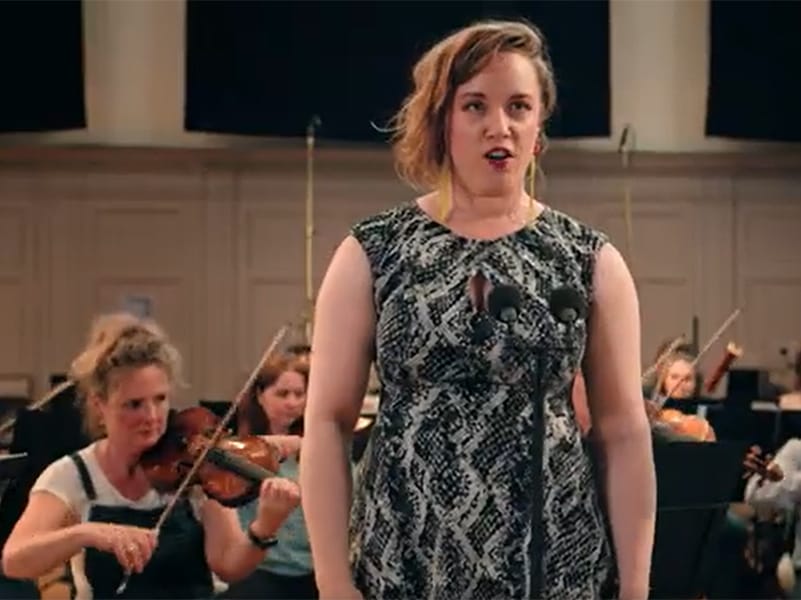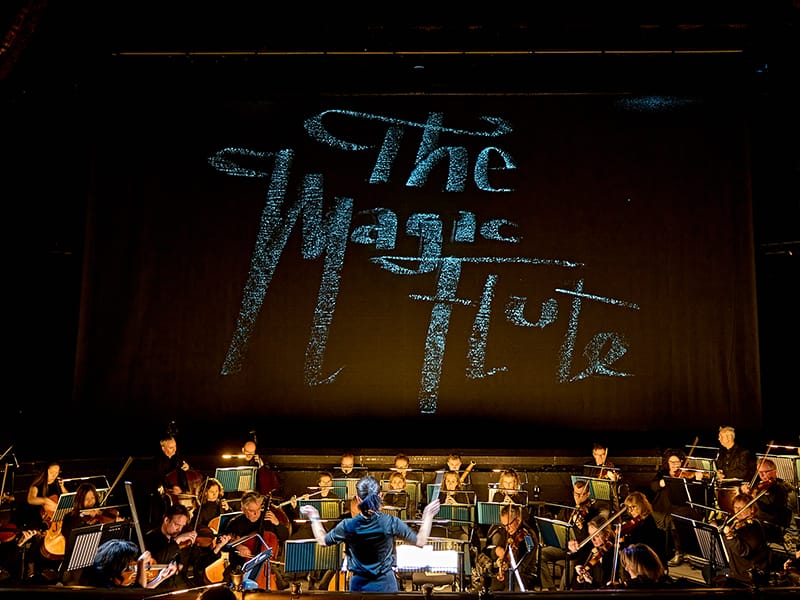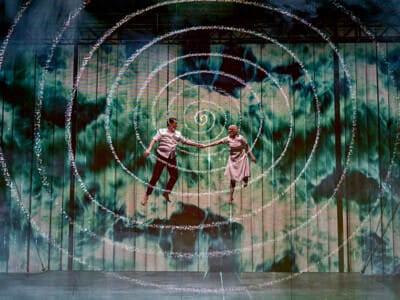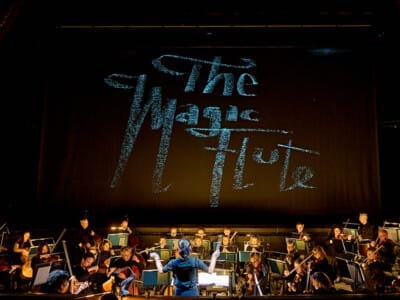Discover: The Magic Flute
One of the greatest operas ever written, Mozart’s timeless classic concerns the search for truth and reason, love and enlightenment.
It follows the adventures of Prince Tamino and the bird-catcher Papageno on their quest to rescue Pamina. To assist their mission, they are given musical instruments enhanced with magical powers, which they deploy to conquer the trials and tribulations placed in their path towards a deeper understanding of true love and happiness.
Synopsis of The Magic Flute
Act I
Chased by a serpent, Prince Tamino finds himself in an unknown land. He faints and is saved by the Queen of Night’s three Ladies. When Tamino comes to, he is approached by the bird-catcher Papageno.
The Ladies return to give Tamino a portrait of the Queen of Night’s daughter Pamina, who has been kidnapped by the evil Sarastro. Tamino is instantly smitten and the Queen of Night arrives to secure his promise that he will do everything in his power to rescue Pamina from Sarastro’s stronghold. The Prince is given a magic flute and Papageno a set of magic chimes as protection; the instruments have a way of charming both man and beast. Additionally, three spirits, acting as guardians and advisors, will lead the way.
Sarastro’s slave Monostatos pursues Pamina but is frightened away by Papageno, who tells Pamina that he and Tamino have come to rescue her.
Meanwhile the three spirits have led Prince Tamino to Sarastro’s Temple. There, he meets a priest who explains to him that it is the Queen of Night who is evil, not Sarastro. Heartened by the news that Pamina is alive, Tamino begins playing his flute; it reveals its magical properties by bringing the forest to life. Pamina and Papageno hear Tamino’s flute and hasten to find him. But they are intercepted and detained by Monostatos. Papageno’s chimes come to their aid, allowing the bird-catcher and Pamina to escape.
Pamina and Tamino see one another for the first time, and fall into a passionate embrace.
Act II
Sarastro sees Tamino as a future leader of his people, who are in the midst of a grave crisis. But in order to prove himself worthy of the role, and of Pamina, Tamino must first undergo several rigorous trials.
Papageno does not share Tamino’s audacity and is only prepared to accompany him after the promise of a wife as his reward. The Queen of Night’s Ladies arrive and try to seduce the two men into abandoning their allegiance to Sarastro, but Tamino and Papageno hold their nerve and pass their first ordeal.
Monostatos tries to kiss the sleeping Pamina, but is frustrated by the entrance of the Queen of Night. Set on revenge, she charges Pamina with the task of murdering Sarastro. Torn by her devotion to her mother and her love for Tamino, Pamina is at a loss. Sarastro enters, reassuring Pamina that he is not out for vengeance, but strives for understanding and forgiveness.
The second ordeal has begun for Tamino and Papageno: a vow of silence. Papageno heartily ignores this, chattering cheerfully with his companion. Pamina finds them, but believes herself betrayed when Tamino refuses to speak to her. Her happiness dashed, she leaves in despair, but Tamino passes the second test. Papageno, on the other hand, is at his wits’ end. He encounters an old woman who, once he has sworn lifelong fidelity to her, reveals herself as a young girl named Papagena. But as he has disobeyed the vow of silence, she is driven away from him. Papageno’s life now seems futile.
Beside herself with grief, Pamina contemplates suicide, but the three spirits intervene, bringing her and Tamino together for the final trials. Protected by the magic flute, Tamino and Pamina successfully undergo fire and water ordeals. The three spirits also manage to prevent Papageno from killing himself, and the bird-catcher is reunited with his Papagena for good.
The Queen of Night and her Ladies, led by Monostatos, once again try to storm the Temple, but the intruders are caught unawares by Sarastro and cast out by the light of the rising sun. As dawn breaks, Tamino and Pamina are hailed for enduring all the ordeals with beauty and wisdom.
The Magic Flute Opera FAQs
Who wrote The Magic Flute?
The Magic Flute was written by composer Wolfgang Amadeus Mozart (1756 -1791), a child prodigy and one of the most well-known classical composers of all time – lending to the impeccable music throughout the opera.
When was The Magic Flute written?
The Magic Flute was written in 1791, just three months before Mozart’s untimely death aged 35. The first performance took place at the Theater auf der Wieden, Vienna, in September 1791.
What is The Magic Flute about?
The plot follows the adventures of Prince Tamino and his comical companion, Papageno, on their search to rescue the Queen of the Night’s daughter, Pamina. To help conquer the trials and tribulations faced on their quest, as well as the evil sorcerer Sarastro, the duo are given magical musical instruments, including a magic flute and a set of enchanted bells.
Where is The Magic Flute set?
The Magic Flute is set in a magical unknown land, filled with mystical creatures, mysterious places and fantastical scenes.
Is The Magic Flute a good opera for beginners?
Yes. A blend of fantasy, comedy, and romance, The Magic Flute is an opera that’s perfect for newcomers.
The fairy-tale-like storyline makes it simple to follow and is engaging for those who are not familiar with opera.
The combination of a variety of characters and a colourful and imaginative production, produces a relatable and enjoyable experience for newbies.
Is The Magic Flute a Masonic opera?
The Magic Flute contains some Masonic themes and symbolism, such as the use of the number three, the All-Seeing Eye, and ritualistic elements. However, the opera was never officially presented as a Masonic work and clearly draws from other sources too, such as folklore.
What type of opera is The Magic Flute?
In terms of opera style, The Magic Flute is referred to as a Singspiel – a German language comic opera with singing and dialogue. Arguably one of the most popular operas of the genre, The Magic Flute features comedy and fairy-tale themes, and is overall light-hearted.







